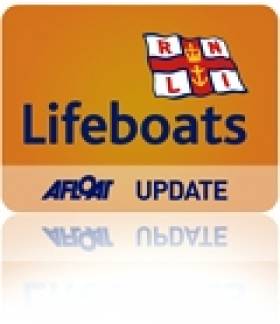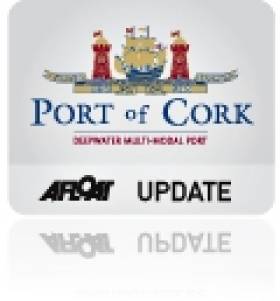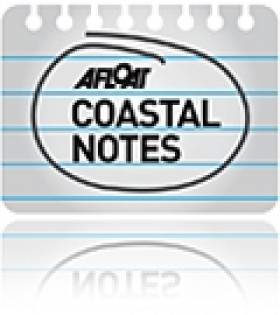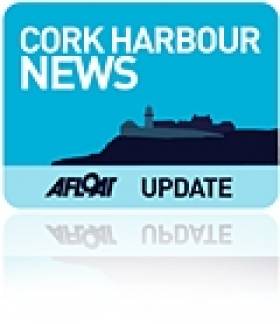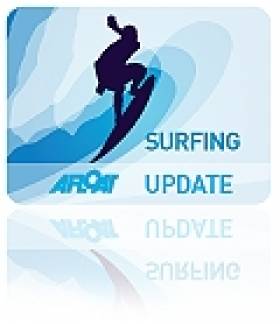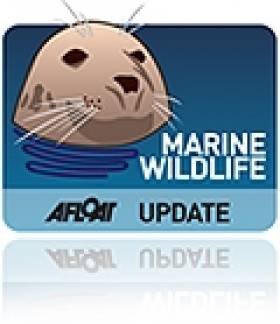Displaying items by tag: documentary
Youghal Lifeboat Radio Doc Traces 175 Years of East Cork Rescues
#rnli – A new radio documentary on CRY104fm entitled "Saving Lives At Sea" airs tomorrow night (Tuesday the 29th of April) at 7pm tracing the history of the Youghal RNLI as it celebrates 175 years in existence.
Beginning with one of Youghal Lifeboats most dramatic rescues on the 1st of August 1984, the programme will trace the History of the Lifeboat station right up to the present day.
In the programme we will hear from a large number of volunteers both past and present from Youghal RNLI who have regularly put their lives at risk to keep the waters of East Cork safe while looking at the changes that have taken place in both technology and in the Lifeboat station since 1839 and in particular since the 1970's when the changes in RNLI technology and capabilities have been vast.
In total Youghal's Lifeboats have been launched on over 340 occasions and have saved over 200 lives which in itself is a remarkable achievement for an organisation which is solely run by volunteers and is dependent on people's goodwill and generosity in order to survive financially and maintain a lifeboat service on our coastline.
The programme will celebrate the bravery and truly heroic actions of Youghal RNLI volunteers by retelling some of the stations most dangerous sea rescues while also examining how a tragedy brought a community together in grief but also highlighted the extraordinary dedication and selflessness of RNLI volunteers which brought comfort to two grieving families.
The programme will also look at the extended RNLI family from the partners and children that remain on shore while the volunteers embark on potentially dangerous rescues to the vitally important fundraising arm of the Youghal RNLI whose often unseen work ensures that the lifeboat service remains intact for the people of Youghal and the surrounding areas.
Above all in what will be compelling listening for all those with an association with the sea "Saving Lives At Sea" will highlight how vital the lifeboat service is to the Community of Youghal while raising awareness of the work this most deserving charity does.
More on www.cry104fm.com
Cork's 'Mega Port' Features In New TV3 Documentary
#PortOfCork - Have you ever wondered about the functions of the Port of Cork, the kind of people who work there, what they do and how many ships visit Cork every day and the types of cargo on board?
You can find out when you tune in to new 'fly on the wall' TV documentary series Cork Mega Port on TV3 starting Monday 28 April at 9pm.
Goldhawk Media produced the series of four hour-long episodes over four months spent living and breathing the Port of Cork.
The documentary crew followed all port employees including management, crane drivers, tug operators, pilots, launch crew and maintenance and engineering staff. Regardless of weather, they have been out on the sometimes high seas, filming the likes of Panamax-size vessels laden with cargo arriving into the port.
The series promises to give an exciting insight not just into the everyday operations of the port and the people behind it, but also highlights its importance to the region and necessity as a gateway for trade both in and out of Munster.
As well as having a serious side, the series will show the lighter side of the port by following some of the characters who have worked there for many years.
The Port of Cork prides itself on having a reliable, long-serving, experienced group of employees, and one thing that is evident within the series is the passion that exists in working at the Port of Cork.
Some staff describe working at the Port of Cork as having the "best job in the world" and from the varied services and operations that the port is involved in, it’s easy to see why.
Speaking about the new series, Port of Cork chief executive Brendan Keating said: “When we were approached by Goldhawk Media on behalf of TV3 back in 2013 and heard their experience and saw their enthusiasm, we jumped at the opportunity to get involved in this production.
"While the series shows everything the port is involved with from operations, to maintenance, the cruise business, community initiatives and our recent port redevelopment plans, it has been the level of enthusiasm from staff which has really shone through and we are very proud to share this with the people of Ireland.”
Cork Mega Port will air over four weeks on TV3 from Monday 28 April at 9pm.
Weapons Lab's Work On Lusitania Doc Falls Foul of US Authorties
#Lusitania - A nuclear weapons lab has found itself in trouble with US authorities over its work on a TV documentary on the sinking of the RMS Lusitania.
The Lawrence Livermore National Laboratory conducted munitions testing at its facility for National Geographic's Dark Secrets of the Lusitania, an investigation into how the passenger liner was torpedoed and sunk off the coast of Cork in May 1915.
But as the Los Angeles Times reports, the testing was a possible violation of strict rules governing the lab's government funding, insofar as doing work for National Geographic that could have been contracted to the private sector.
As previously reported on Afloat.ie, the documentary's findings have been disputed by the Lusitania's millionaire owner Gregg Bemis, who is hopeful of funding one more return expedition to the wreck site off the Old Head of Kinsale.
The LA Times has more on the story HERE.
New Documentary Charts Dutch Teen's Solo Round-The-World Voyage
#LauraDekker - A new documentary is bringing the inspirational story of young Dutch circumnavigator Laura Dekker to the big screen.
As Scuttlebutt News reports, Maidentrip was produced by a team of female filmmakers who followed the teenager over two years of her life as she made history by sailing solo around the world, with no follow boat or support team.
Dekker was just 14 years old when she set out on her own in January 2010, after fighting a court battle for the right to achieve her dream.
Two years later, aged 16, water baby Dekker sailed into Sint Maarten in the Caribbean to complete her voyage and smash the world record for the youngest solo female circumnavigation.
Catching up with Dekker at various ports of call along her route, the filmmakers combined their footage with candid self-shot scenes from the young sailor herself alone on board her 26ft vessel.
The end result is a remarkable coming-of-age story as Dekker, already mature beyond her years, literally and figuratively grows up at sea.
Scuttlebutt News has more on the story HERE.
'Message In A Bottle' Radio Doc Shortlisted For Prix Italia Award
#Radio - RTÉ Radio's Documentary on One strand has made the shortlist of the 2013 Prix Italia broadcasting awards for a wonderful tale of a connection made across the ocean.
Listed among the top three for 'Overall Quality' in the awards shortlist, Message in a Bottle begins on Christmas Day 1945, when 21-year-old American servicemen Frank Hayostek stuffed a note in a bottle and threw it from the deck of his troop carrier.
After eight months at sea, the bottle washed up on a beach near Dingle where it was found by 18-year-old Breda O'Sullivan, who began a correspondence with Frank that soon blossomed into a firm friendship.
Saving up for six years as they wrote back and forth, Frank finally made the trip to Ireland to meet Breda in person - with the whole world watching.
Made by Peter Mulryan with assistance from Liam O'Brien, and originally broadcast on RTÉ Radio 1 on 4 August 2012, the 45-minute documentary is available to stream or download from the RTÉ website.
The winners are due to be announced this afternoon at 4pm CET with a live stream available from the Prix Italia homepage.
Cobh History Radio Doc Is A Blast From The Past
#CorkHarbour - Many thanks to the Hurdy Gurdy Museum in Howth (@HurdyGurdyRadio on Twitter) for tipping us off to this fascinating radio documentary on the history of the port of Cobh in Cork Harbour, first broadcast all the way back in August 1954.
The programme, produced for Radio Éireann, charts the history of the town well before the visit of the ill-fated Titanic in 1912 and its role as the point of departure for emigrants during the famine, all the way back to its beginnings in 1780.
The entire documentary is available to stream or download from the RTÉ Documentary on One website HERE.
Surfing Film Unites Descendants of Blaskets King
#Surfing - The Blasket Islands are the setting for a new documentary following the exploits of two surfers descended from the ancestral 'king' of the island chain.
IrishCentral reports on The Crest, the story of two distant cousins from opposite sides of the United States - Andrew Jacob from Massachusetts and Dennis Kane from California. Though previously unknown to each other, the two nevertheless share a deep passion for surfing.
And it's the waves that bring them together as they unite in the land of their great-great-grandfather to indulge their obsession and ride the giant swells for which the west of Ireland is becoming so renowned.
Indeed, Canada's National Post is just the latest to discover the attractions of surfing at Lahinch and the Cliffs of Moher
Crowdfunded via a Kickstarter campaign, the documentary crew already shot footage in Cape Cod and San Diego before decamping to the Blaskets off Kerry last month to shadow the cousins as they connect to their roots.
The film is directed by Mark Corvino, who co-directed the current film festival favourite music documentary A Band Called Death.
#Lusitania - The owner of the Lusitania may get his wish for a return dive to the wreck of the ill-fated passenger liner after the Minister for Heritage endorsed plans for a fresh investigation into its sinking.
The Irish Times reports that Minister Jimmy Deenihan has "agreed to a broad set of exploration objectives" with Gregg Bemis, the American millionaire businessman who has had had a financial interest in the wreck since 1968, and sole ownership since 1982.
As previously reported on Afloat.ie, Bemis had been seeking permission from the Government since last September after disputing the findings of a documentary made during an expedition to the wreck in the summer of 2011.
The cruise liner - a rival of the Titanic in its day - was hit by a torpedo from a German U-boat off the Old Head of Kinsale on 7 May 1915, during the First World War, sinking in just 20 minutes and taking 1,198 lives.
However, there have long been accounts of a second explosion on the sinking vessel before it was submerged - leading some to believe that it was carrying Allied munitions in its cargo.
Bemis staged his previous expedition in a bid to discover once and for all what really happened to the Lusitania. But last year he said that the National Geographic documentary team behind 'Dark Secrets of the Lusitania' used "insufficient data" to conclude that the second explosion was from a boiler in the bowels of the ship.
The businessman's ambitions had also been thwarted by a long-running dispute with Leinster House over the State's heritage rights to the wreck site and the effect of exploration on its condition.
Minister Deenihan is reviewing a new licence application that would involve numerous dives to the wreck over the next three years, including the centenary year of the Lusitania's demise in 2015.
The Irish Times has more on the story HERE.
Live Giant Squid Filmed For First Time
#MarineWildlife - The video above is a world first for marine biology - the first known footage of a living giant squid in the ocean.
The remains of the elusive beast have been captured before, but news has now come out that a team of marine scientists finally recorded video of a living specimen deep below the surface off Japan's Ogasawara islands.
As RTÉ News reports, last July the team - working on a documentary for Discovery and Japanese TV network NHK - used a small submersible equipped with near-infrared lights invisible to both squid and human eyes.
After 100 attempts, they finally attracted the attention of a three-metre long cephalopod - small by giant squid standards, but the largest ever seen alive.
"It was stunning." said zoologist and team leader Tsunemi Kubodera. "I couldn't have dreamt that it would be so beautiful. It was such a wonderful creature."
The documentary Monster Squid: The Giant Is Real will be broadcast on the Discovery Channel in the US on 27 January, and hopefully will appear on Discovery UK & Ireland soon after.
TV3 Christmas Special to Feature 'Unsung Heroes' of Arklow RNLI
#RNLI - Volunteers from Arklow RNLI in Co Wicklow are to feature in a Christmas special to be broadcast on TV3.
The documentary, Unsung Heroes, will highlight the efforts of those who provide the essential rescue service throughout the year, including over the festive season.
It will be broadcast twice over Christmas, first at 8pm on Friday 21 December and again at 8pm on Sunday 23 December.
A TV3 film crew spent the morning of Tuesday 27 November at Arklow RNLI filming at what is the oldest of the 44 lifeboat stations in Ireland.
Producer Patrick Kinsella and cameraman Vinnie Broderick shadowed the volunteers on a training-based exercise when they launched their all-weather Trent class lifeboat, the Ger Tiighcelarr.
"The documentary is about unsung heroes," said Kinsella, "and I suppose given my own experience having worked in the shipping industry, I feel the RNLI and its people – the men and women who run and manage this organisation - cannot be praised enough for putting their lives at risk to save others, and I think this programme is a good way to shine a light on the work they do."
During the exercise, Kinsella and Broderick had the opportunity to experience first-hand and get a glimpse of the level of training required by RNLI volunteers to become highly skilled and efficient in order to carry out lifesaving work which can often be difficult and sometimes dangerous.
Interviews were carried out with lifeboat operations manager Jimmy Tyrell, coxswain Ned Dillon and volunteer crew member Stephen Furlong. Tyrell said filming with TV3 was a great opportunity to showcase the commitment of volunteers, not only in Arklow but in the many other coastal and inland water communities across Ireland.
He said the RNLI wouldn’t exist without fundraising, adding that the charity was totally reliant on the generosity of the public and indebted to work of fundraisers at station branches as well as those raising money inland.
Tyrell also said crew members would happily exchange their Christmas dinner and the comfort of their homes should the need arise this year to help anyone who may find themselves in difficulty at sea.
"It is because of the willingness and selfless nature of our volunteers, who will readily swap leisure, comfort and sleep for cold, wet and fatigue that the charity can provide an on-call, 24-hour lifeboat search and rescue service here," he said. "The RNLI depends on its volunteers who give their time, skill and commitment, even at Christmas time.
"Indeed, while our lifeboats are busy all year round, some of the most challenging callouts can occur over the winter months. And while most of us will be enjoying the Christmas festivities with our loved ones, we know that somewhere, RNLI lifeboats will be launched to help save lives at sea."


























